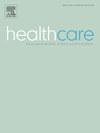One cutoff is not enough: Assessing different area deprivation index cutoffs for insurance types on surgical Desirability of Outcome Ranking (DOOR)
IF 2.1
4区 医学
Q3 HEALTH POLICY & SERVICES
Healthcare-The Journal of Delivery Science and Innovation
Pub Date : 2025-05-15
DOI:10.1016/j.hjdsi.2025.100762
引用次数: 0
Abstract
Background
Social Determinants of Health impact health outcomes. Area Deprivation Index (ADI) is used to risk-adjust for neighborhood affluence/deprivation but guidance on choosing deprivation cutoffs is lacking. We hypothesize that different ADI cutoffs are required for different insurance types.
Methods
National Surgical Quality Improvement Program data 2013–2019 merged with electronic health records from three academic healthcare systems. Desirability of Outcome Ranking (DOOR) assessed the association of ADI cutoffs for different insurance types, adjusted for operative stress, frailty, and case status (elective, urgent, emergent). Secondary analyses assessed the association of ADI with case status.
Results
Patients with Private insurance living in areas with ADI>85 had higher/worse DOOR outcomes, which lost significance after adjusting for case status. Medicare cases with ADI>75 exhibited higher/worse DOOR outcomes even after adjusting for case status. ADI was not associated with outcomes in the Medicaid and Uninsured groups. High ADI was associated with increased odds of urgent and emergent cases for the Private and Medicare but not Medicaid or Uninsured groups.
Conclusions
ADI is a useful metric to identify at-risk patients and can be used for risk adjustment. Health systems must understand their population demographics and use their data to determine ADI cutoffs. Patients in deprived neighborhoods have higher odds of urgent and emergent surgeries, despite having Private insurance or Medicare, suggesting that delays/barriers to primary and preventive care may be a major driver of worse outcomes. While insurance coverage is important, healthcare policies supporting reductions in urgent/emergent cases could have the largest impact on improving outcomes.
一个分界点是不够的:评估不同保险类型的区域剥夺指数分界点对手术结局满意程度排序(DOOR)的影响
健康的社会决定因素影响健康结果。区域剥夺指数(ADI)用于社区富裕/剥夺风险调整,但缺乏选择剥夺截止点的指导。我们假设不同的保险类型需要不同的ADI截止值。方法将2013-2019年国家外科质量改进计划数据与来自三个学术医疗保健系统的电子健康记录合并。结果排序的可取性(DOOR)评估了不同保险类型的ADI截止值的相关性,并根据手术压力、虚弱和病例状态(可选、紧急、紧急)进行了调整。二次分析评估了ADI与病例状态的关系。结果居住在ADI>;85地区的私人保险患者的DOOR结果较高/较差,但在调整病例状态后不具有显著性。即使在调整了病例状态后,adi75的医疗保险病例也表现出更高/更差的DOOR结果。在医疗补助和未参保组中,ADI与结果无关。高ADI与私人和医疗保险的紧急和紧急病例的几率增加有关,而与医疗补助或无保险群体无关。结论sadi是识别高危患者的有效指标,可用于风险调整。卫生系统必须了解他们的人口统计数据,并使用他们的数据来确定每日摄入量的下限。贫困社区的患者尽管拥有私人保险或医疗保险,但紧急和紧急手术的几率更高,这表明初级和预防性护理的延误/障碍可能是导致更糟糕结果的主要原因。虽然保险覆盖面很重要,但支持减少紧急/紧急病例的医疗保健政策可能对改善结果产生最大影响。
本文章由计算机程序翻译,如有差异,请以英文原文为准。
求助全文
约1分钟内获得全文
求助全文
来源期刊

Healthcare-The Journal of Delivery Science and Innovation
HEALTH POLICY & SERVICES-
CiteScore
4.90
自引率
0.00%
发文量
37
期刊介绍:
HealthCare: The Journal of Delivery Science and Innovation is a quarterly journal. The journal promotes cutting edge research on innovation in healthcare delivery, including improvements in systems, processes, management, and applied information technology.
The journal welcomes submissions of original research articles, case studies capturing "policy to practice" or "implementation of best practices", commentaries, and critical reviews of relevant novel programs and products. The scope of the journal includes topics directly related to delivering healthcare, such as:
● Care redesign
● Applied health IT
● Payment innovation
● Managerial innovation
● Quality improvement (QI) research
● New training and education models
● Comparative delivery innovation
 求助内容:
求助内容: 应助结果提醒方式:
应助结果提醒方式:


